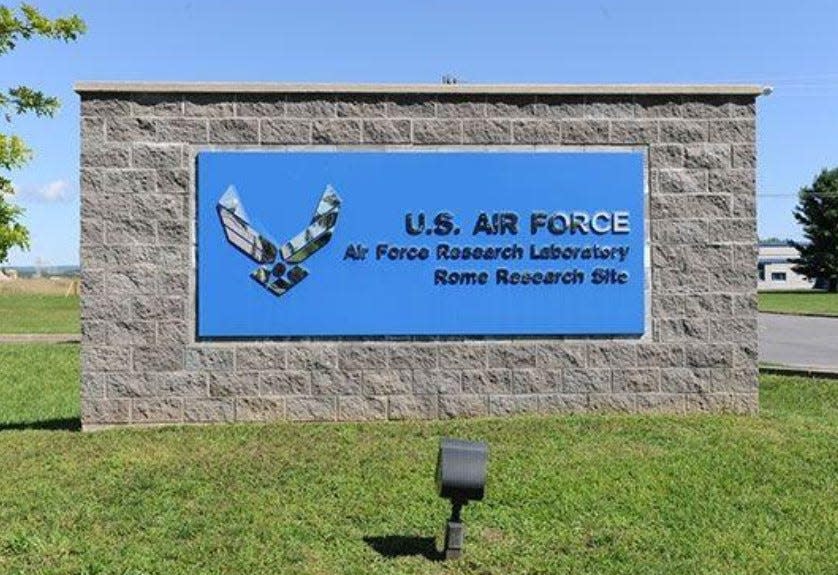If you see smoke in Verona next week, don't worry
If you see a white plume, or a gray cloud, of smoke rising from somewhere in the town of Verona one day during the week of May 5, don’t panic.
Chances are it’s from a prescribed burn taking place on 495 acres that’s part of the Air Force Research Laboratory in Rome.

The Verona Text Annex, as the area is known, touches Route 31 at its southernmost point and lies between Routes 46 and 365. Brandy Brook flows through the property, which hasn’t been used by the lab since 1999.
The property is mostly forest and wetlands with several “inoperable” buildings and infrastructure improvements just off Germany Road on the eastern edge, according to a statement from the lab. The prescribed, or controlled, burn is planned for 140 acres on Germany Road in five smaller parcels depending on weather and burn conditions.
It will be the first prescribed burn ever on the site.
Prescribed burn
During a prescribed burn, trained personnel ignite low-intensity fires to remove excess fuel, such as vegetation and dead wood, that would let any wildfires burn hotter and longer.
An AFRS draft natural resources management plan from 2020 lists the benefits of controlled burns as minimizing the spread of invasive species, pests and diseases; improving habitat for endangered or threatened species; increasing essential nutrients in soil; promoting native plants; increasing wildflower diversity and pollinator habitat; and providing habitat for birds that nest in grasslands.
The smoke will be visible from Turning Stone Resort Casino, which is 6.1 miles away, and from several major roads, including the New York State Thruway, and state routes 365 and 31, all of which are within three miles of the area to be burned.
The Vernon-Verona-Sherrill High and Middle schools and the J.D. George Elementary School are located within three miles of the burn site as are a number of residences. They will be monitored and the fire won’t be ignited if “adverse impacts are inevitable,” the statement said.
And the burn staff will check weather conditions within 30 minutes of ignition to make sure wind speeds and directions won’t pose a risk.
Reactivation?
The Air Force is interested in using the annex again, according to a draft of a natural resources management plan, written in 2020, for the laboratory property in Rome and its four test annexes in Oneida and Madison counties.
A final version of the plan was approved last year in April, but it is not yet available online.
“The Air Force has not yet made any decisions on the next plan for the (Verona) test annex,” an Air Force Research Lab spokesman said. “However, they are keeping all options open.”
The final plan does include priority goals for the Verona annex: Removing invasive species and establishing a native/pollinator habitat for wildlife.
“This prescribed burn is the first step towards achieving these goals,” the spokesman said. “Controlled burns are commonly used across the United States for these purposes.”
Timing
Property owners in New York aren’t allowed to burn residential brush from March 16 through May 14 every year because of the heightened risk of wildfires in the spring.
But the timing of the test annex burn was chosen for safety, the lab spokesman said.
Weather conditions play a vital role in choosing when to burn and suitable days are determined by variables such as temperature, wind speed and relative humidity, he said.
More: State unveils new initiative: Mohawk Valley Empowers
More: Forbes list of 500 best employers for diversity: Which upstate firms are on it?
“In this area, prescribed burns are conducted before May 15th, which is prior to the green-up of vegetation,” he said. “It is essential to note that prescribed burns are regulated by law and are exempt from the annual residential brush burn ban, which is effective from March 16 to May 14. Moreover, AFRL followed the federal regulations and notified all agencies as required.”
Wildlife impact
Asked about the impact of the fire on wildlife, especially at a time of year when many birds have yet to fledge, the spokesman provided an emailed statement:
“Prescribed fire is used to re-establish ecosystem drivers on the landscape. It is an important tool to manage fire and reduce wildfire risk to communities. A scientific prescription outlines the objectives, fuels, size, and environmental conditions under which it will burn. Prescribed fires create diverse habitats and help prevent destructive fires by reducing available materials to burn. They are less intense than wildfires and cause minimal impact on wildlife.”
Managing risk
What if, despite all the weather analysis and precautions, the fire does get out of control?
Backup is at hand. Local and county-wide fire departments know about the burn and contingency plans are in place, including local firefighting resources that have been placed on standby should an emergency develop, the spokesman said.
“If there is an uncontrollable event,” he continued, “all authorities will be notified immediately so that the public can be informed in a timely manner.”
But the fire won’t be ignited until fire specialists have compared actual conditions to those outlined in the burn plan and will postpone the fire if they don’t match, he said.
Driving
If you see smoke from the burn while driving, slow down and turn on your low beams, the lab release suggested.
Always use caution around prescribed burns and smoke, it said.
This article originally appeared on Observer-Dispatch: Air Force Research Laboratory in Rome setting fire to Verona annex
